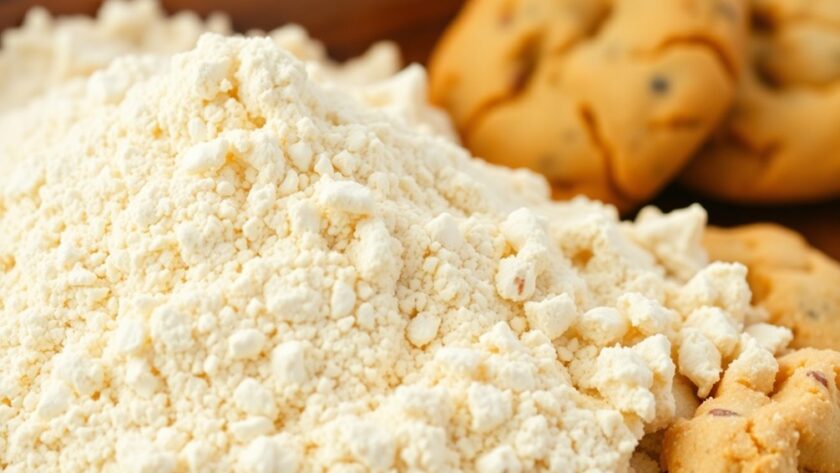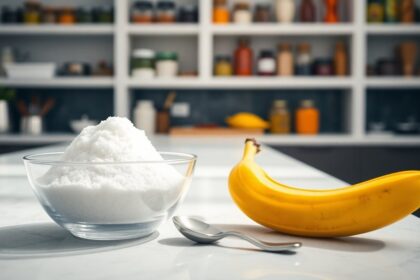Yes, you can use unbleached flour for cookies, and it greatly affects their texture. Unbleached flour has a higher protein content, promoting gluten formation that leads to denser, chewier cookies. They'll be thicker since this flour spreads less during baking. You'll also notice a richer, nuttier flavor, enhancing your cookie experience. Just remember that unbleached flour absorbs more liquid, so you might need to adjust your moisture levels for the perfect dough. If you want to learn tips on how to best use unbleached flour in your cookie recipes, there's more to explore.
Understanding Unbleached Flour
When you choose unbleached flour for your cookies, you're opting for a less processed option that retains more nutrients and flavor. This type of flour has a protein content similar to bleached flour, around 10-12%, but it offers a denser texture, making your cookies chewy and hearty. The natural aging process of unbleached flour enhances gluten development, essential for achieving that perfect cookie structure. When baking, you'll notice that cookies made with unbleached flour spread less, resulting in thicker, sturdier treats with crisp edges. If you're aiming for a more rustic or wholesome cookie texture, unbleached flour is your go-to choice. Your cookies won't only taste better but will also have a more satisfying bite! Additionally, using unbleached flour may complement the gluten-free flour used in some recipes, enhancing the overall texture and flavor. Cookies made with unbleached flour often feature a chewy texture that many bakers prefer. Moreover, using unbleached flour can also provide nutritional benefits that support healthier baking options.
Nutritional Benefits of Unbleached Flour
When you choose unbleached flour for your cookies, you're not just baking; you're also boosting their nutritional value. This flour retains more vitamins and minerals, offers a higher protein content, and provides more fiber than its bleached counterpart. Additionally, whole, unprocessed ingredients can further enhance the health benefits of your baked goods. Incorporating nutrient-rich flours into your cookie recipes can significantly improve both texture and flavor. These benefits can enhance your cookies' texture and health profile, making them a more satisfying treat. Additionally, using wholesome ingredients like oats can further improve the nutritional benefits of your baked goods.
Higher Nutrient Retention
Although many bakers may overlook the type of flour they use, opting for unbleached flour can considerably enhance the nutritional value of your cookies.
Unbleached flour retains more of the bran and germ from the wheat, resulting in higher levels of essential nutrients, vitamins, and minerals. This less processed flour is a healthier choice for baking cookies, as it preserves natural nutrients that bleached flour often loses.
Additionally, unbleached flour contributes to a more balanced diet and brings a richer, nuttier flavor to your baked goods.
Fiber Content Comparison
Choosing unbleached flour for your cookies can considerably enhance their fiber content, which is essential for a healthy diet. Here are a few key benefits:
- Higher Fiber Content: Unbleached flour retains more bran and germ, offering 2-3 grams of fiber per 100 grams.
- Improved Satiety: The increased fiber helps you feel fuller for longer, aiding in weight management.
- Better Carbohydrate Absorption: It slows down carbohydrate absorption, positively impacting blood sugar levels.
With unbleached flour, you're not just improving the nutritional profile of your cookies; you're also achieving a richer flavor that elevates your baking.
Protein Quality Differences
While many bakers might overlook the importance of flour type, using unbleached flour can greatly impact the protein quality in your cookies.
Unbleached flour typically retains more of its original protein structure, boasting a protein content of 10-12%. This higher protein level enhances gluten development, resulting in a chewier, denser texture that's perfect for cookies.
Additionally, unbleached flour contains more vitamins, minerals, and fiber due to less processing, boosting its nutritional value compared to bleached flour.
The natural aging process of unbleached flour further improves dough elasticity, making your baked goods not only tastier but also healthier.
Texture Differences in Cookies
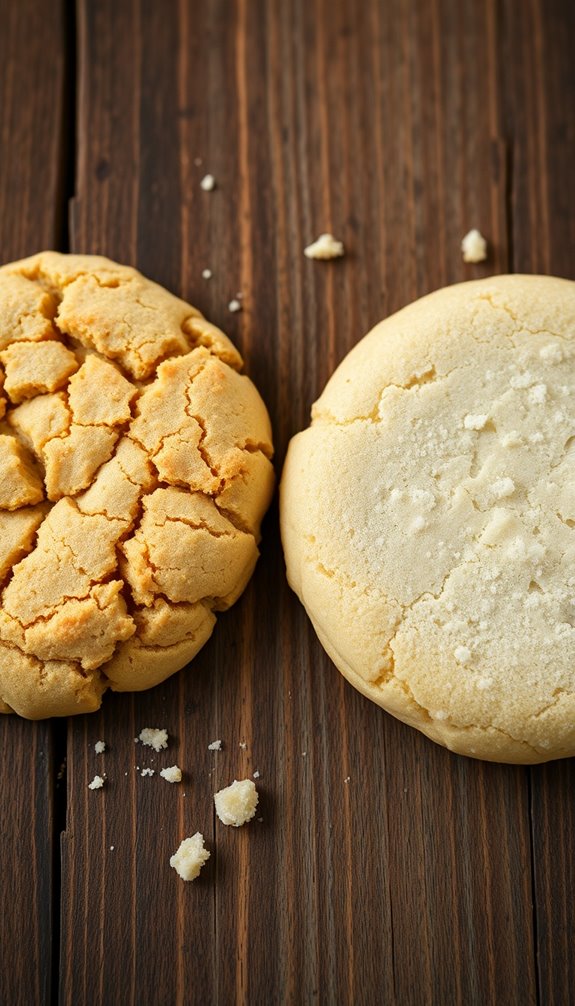
When it comes to baking cookies, the choice of flour greatly impacts their texture. If you opt for unbleached flour, you'll notice some key texture differences:
- Chewy Cookies: The higher protein content enhances gluten formation, resulting in denser, chewier cookies. This is similar to how keeping butter cold can also affect the texture of baked goods.
- Thicker Cookies: Unbleached flour tends to spread less during baking, creating thicker, more substantial cookies. This characteristic is similar to how gluten-free flours can also provide a unique texture without traditional flour.
- Rich Flavor: This flour retains more natural wheat flavor, giving your cookies a nuttier profile. Moreover, the aging process of unbleached flour improves liquid absorption, leading to a balanced moisture content.
Additionally, using gluten-free alternatives allows for a broader range of textures and flavors, supporting those with gluten sensitivities. If you want sturdier, chewier cookies that stand out in flavor and texture, unbleached flour is a great choice for your baking process.
Baking Performance With Unbleached Flour
Baking with unbleached flour can elevate your cookie game, as its higher protein content contributes to a denser, chewier texture. The enhanced gluten content allows for better moisture absorption, which improves your cookie structure during baking. You'll notice that cookies made with unbleached flour have a richer, nuttier flavor, making each bite more enjoyable. Furthermore, many traditional baked goods, like ancient Greek cheesecake, showcase how diverse ingredients can enhance texture and flavor. Additionally, using unbleached flour in your recipes can complement high-protein vegan options, providing an excellent base for nutritious cookies.
One advantage is that they typically spread less, resulting in thicker cookies with a firmer texture. However, when using unbleached flour, you might need to adjust your mixing time and liquid ratios to achieve the desired cookie texture. Additionally, consider using healthier ingredient swaps to further enhance the nutritional profile of your cookies. Embrace the unique qualities of unbleached flour to bring out the best in your baking performance and delight your taste buds.
Recommended Recipes for Unbleached Flour
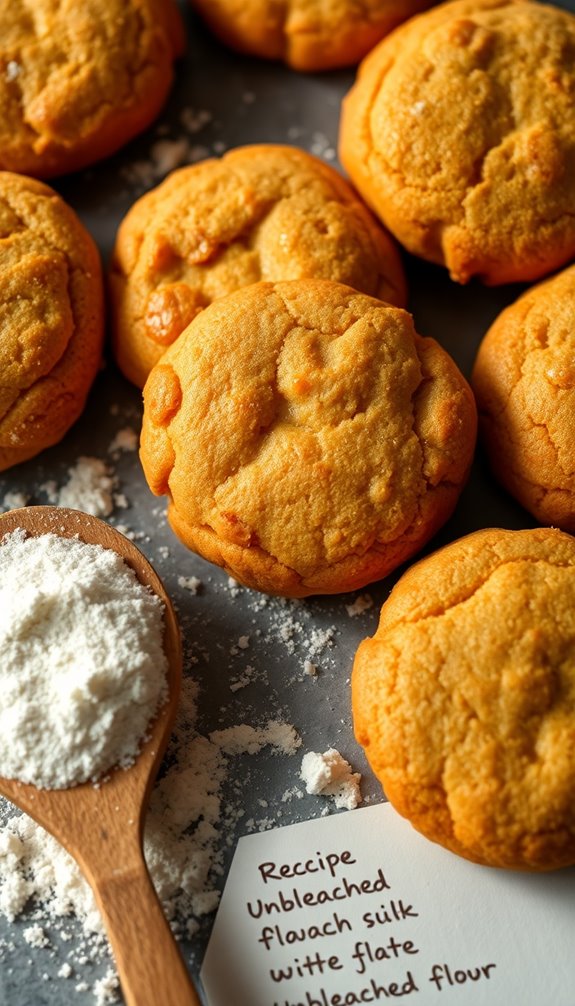
Unbleached flour opens up a world of delicious cookie possibilities, showcasing its unique qualities in various recipes.
Here are three must-try cookie recipes using unbleached flour:
- Chocolate Chip Cookies: Enjoy a firmer texture with crisp edges, thanks to the higher protein content in unbleached flour.
- Sugar Cookies: Expect a slightly denser, richer flavor that enhances the overall baking experience.
- Oatmeal Cookies: Substitute with unbleached whole wheat flour for added nutrition and a nuttier taste.
When making these cookies, don't forget to let the dough rest before baking. This step improves hydration, enhancing both flavor and texture.
With unbleached flour, you're bound to create cookies that aren't just tasty but also uniquely satisfying! Additionally, you can experiment with different baking methods to elevate your cookie game.
Adjusting Liquid Content for Cookies
When you switch to unbleached flour, you'll notice it absorbs more liquid, which can impact your cookie dough's consistency. To maintain the right texture, you might need to adjust the moisture levels by adding an extra tablespoon or two of liquid. Testing the dough before baking is key, as different brands can vary in how much liquid they soak up. Additionally, the absorption properties of flour can significantly influence the overall texture and structure of baked goods. Using simple ingredients like those in classic recipes can also help in achieving the desired cookie consistency.
Liquid Absorption Variations
Understanding how unbleached flour interacts with liquid is essential for achieving the perfect cookie texture. Here are three key points to take into account:
- Liquid Absorption: Unbleached flour absorbs liquid more effectively, which can lead to denser cookies if you don't adjust the liquid content.
- Gluten Formation: Its higher protein content promotes gluten formation, requiring extra moisture for a balanced dough.
- Chewiness vs. Spread: The right hydration levels help you achieve that ideal balance between chewiness and spread.
When using unbleached flour, take into account slight recipe adjustments to incorporate additional liquid. This helps prevent overly dry or crumbly cookies and enhances overall hydration.
Allowing the dough to rest can also improve texture, ensuring a firmer structure in your final cookies.
Adjusting Moisture Levels
To achieve the perfect cookie consistency, you'll need to adjust moisture levels when using unbleached flour. This type of flour has a higher protein content and denser texture, which means it absorbs more liquid.
You might want to add an extra tablespoon of liquid per cup of unbleached flour to reach the desired cookie texture. Keep an eye on your dough's hydration; too little moisture can lead to dry, crumbly cookies.
Consider adding ingredients like milk or an extra egg yolk for added moisture without sacrificing texture. Experimenting with liquid adjustments, such as increasing the liquid by 10%, can result in chewier cookies, enhancing both flavor and cookie consistency.
Comparison With Bleached Flour
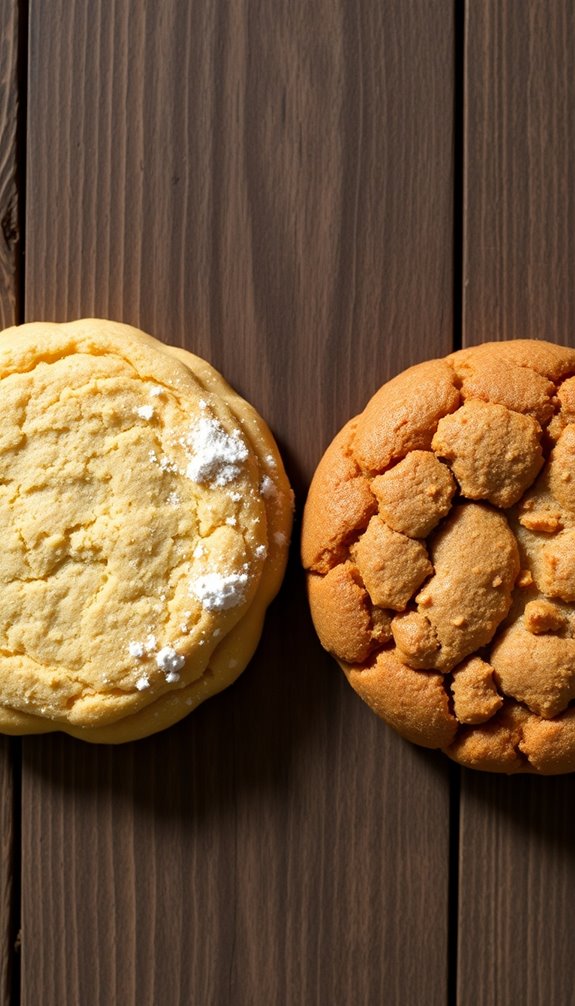
While both unbleached and bleached flour can be used for cookies, the differences in their composition notably affect the final product.
Here's how they compare:
- Texture: Unbleached flour, with its higher protein content, creates denser, chewier cookies, while bleached flour yields softer, fluffier textures.
- Spread: Cookies made with unbleached flour spread less, resulting in thicker, rustic-looking cookies, compared to the more pronounced spread from bleached flour.
- Flavor Profile: Unbleached flour enhances the cookie's flavor, offering a richer, nuttier taste, while bleached flour can lead to milder flavors.
When you're baking cookies, choosing the right flour considerably impacts cookie texture and overall enjoyment.
Tips for Using Unbleached Flour
When you choose unbleached flour for your cookie recipes, there are a few tips that can help you get the best results.
First, remember that unbleached flour absorbs more moisture, so you might need to adjust the liquid content in your recipe. This adjustment will enhance your dough consistency and guarantee a delightful texture.
Allow your cookie dough to rest for at least 30 minutes; this relaxation helps improve both flavor and texture by allowing the gluten to hydrate effectively.
For better measurements, sifting or aerating unbleached flour before measuring can prevent overly dense cookies.
Finally, using unbleached flour will give your cookies a slightly darker color and a more robust taste, elevating your cookie baking to new heights.
Conclusion
In the world of baking, unbleached flour is like a hidden gem, waiting to elevate your cookies to new heights. Its slightly coarser texture brings a rustic charm, creating cookies with a delightful chew and depth. While it may require a bit of liquid adjustment, the reward is a batch of treats that are golden and inviting, with flavors that dance on your palate. So, roll up your sleeves and let unbleached flour weave its magic into your next cookie adventure!

